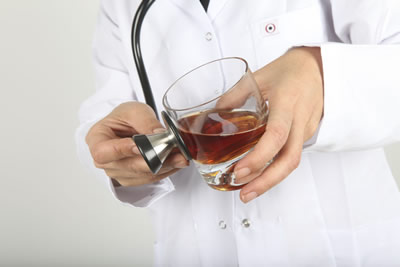Lesson 15: Review and Summation
Attention

Click HERE to read an article on Physicians who become Addicted
Learning Outcomes
Upon completion of this lesson's material, students will
- State the case for SUDs as mental disorders
- Enumerate the characteristics of a mental disorder
- List the things that an MHRT/C can do to help their clients who have co-occurring disorders
- Compare and contrast different approaches to helping with SUDs
Teaching
By now, when you read the article on physician drinking problems in the Attention section, you may feel dismay at the misunderstandings of these highly educated professionals. They seem to think that substance use related to stress should not afflict physicians or that if it does, it reflects character flaws. They see AUD rates of 10-15% as abnormally high although they are in the general range that we would expect for all occupational groups because the population-wide base rate (which we now believe is largely connected to genetic predisposition) is in this range. What we do not see in this article is an understanding that physicians who develop this problem have a chronic, progressive neurophysiologically based disorder that requires compassionate treatment the same as any other chronic progressive (medical) disorder. The article has some strengths in describing the social and sub-cultural issues of the medical community and how they interact with substance use, but it fails to recognize that doctors, like everyone else, can have genetic factors that predispose them to SUDs and that treatment begins with recognizing this problem as a disease.
Remember how DSM-5 defines mental disorders:
- a behavioral or psychological syndrome or pattern that occurs in an individual (e.g. drinking that causes repeated social problems or drinking that the person can't stop when they want to or drinking that takes up the whole day every day)
- the consequences of disorders are clinically significant distress (e.g., a painful symptom) or disability (i.e., impairment in one or more important areas of functioning)
- must not be merely an expectable response to common stressors and losses (for example, the loss of a loved one) or a culturally sanctioned response to a particular event (for example, substance induced trance states in religious rituals)
- that reflects an underlying psychobiological dysfunction (that is a dysfunction in a particular part of the brain relating to observable cognitive or behavioral problems)
- that is not solely a result of social deviance or conflicts with society (such as drug or alcohol use that is supported by a person's ethnic or sub-cultural group)
- that has diagnostic validity using one or more sets of diagnostic validators (e.g., prognostic significance, psychobiological disruption, response to treatment)
- that has clinical utility (for example, contributes to better conceptualization of diagnoses, or to better assessment and treatment)
SUDs meet the 1 through 7 criteria.
As an example of criteria 3 and 5, we did discuss in our Lesson on hallucinogens religious use of hallucinogens that is culturally sanctioned and use of hallucinogens by the counter-culture movement of the 1960’s that was an example of social deviance. But even with peyote use by Indigenous Peoples (Native Americans) or LSD use by flower children, a person may suffer psychotic symptoms that require psychiatric care if the symptoms persist and cause clinically significant distress or disability (criterion 2).
Historical Viewpoint
Historically SUDs have been seen to reflect character flaws that lead the person to abuse a substance like alcohol that others can keep under control. Hopefully by now we all understand that although choice plays a role with these disorders as it does with most disorders (e.g. diabetes, hypercholesterolemia), bad choices do not define SUDs. Like Type II diabetes, where obesity and lack of exercise and poor diet play a role but which cannot occur without the genetic predisposition, SUDs, may occur in the context of lifestyle decisions ( heavy drinking, poor stress management, poor use of social supports) but cannot exist without changes in neurophysiology that meet criterion 4 for mental disorders. These neurophysiological changes may not always be related to genetic predisposition but based on current research that is the most likely explanation.
Incidentally, it is worth noting that Type 2 diabetes and hypercholesterolemia are as difficult and frustrating to treat as SUDs. In fact most chronic diseases require long-term treatment strategies with lifestyle changes and ongoing physician contact. Why would SUDs (which by definition are chronic and progressive) be any different?
Yet many people are angry when people with addiction don’t get better after a single treatment episode when what is needed is ongoing help over a period of years just as with heart disease, multiple sclerosis, irritable bowel syndrome, and other chronic progressive diseases
Advantages of the Scientific Approach
The advantage to following the science here is that in our culture medical problems are generally seen as a focus for compassionate care rather than condemnation, invocation of shame or punishment.
The genetic theory and the disease theory of SUDs may be modified or understood differently in future times. But for now they comprise the result of a long hard battle to take substances and the problems associated with them out of the realm of blame and shame and into the realm of the scientific and humanistic understanding of human behavior.
You have learned that substances are generally desired by humans (and indeed other species) because they cause an enhanced response in the reward center of the brain.
Substances differ in chemical effects, but generally have a final common pathway causing increased presence of dopamine in the reward center.
Both the final common pathway and the earlier differences in chemical effects are important in treating the substance disorder and so we have labored to understand how substances differ from one another and the different categories of stimulants, hallucinogens, sedatives, dissociatives, and others.
We have also tried to understand how people come to be aware of a need for change and how to enhance motivation and to acquire successful tools for change.
We understand that compassion and valuing the other as having an inherent worth and deserving of self-actualization is at the heart of helping.
MHRT/Cs as community support/case managers help clients with co-occurring disorders to:
- Sort out what they want and need.
- Figure out how to achieve their goals in fulfilling their wants and needs.
- Learn to accept and live with the parts of their lives that they cannot change.
- Develop the skills that accomplish the first three objectives.
- Deal with handicaps and barriers associated with their disorders.
- Find and acquire the resources they need to accomplish all of the above.
Different Approaches
Finally, we now know that there are different approaches that recognize SUDs as a disease but differ in how they treat the disease. The 12 Step approach seen in AA and other self-help groups emphasizes a spiritual approach to the disease including recognition of powerlessness, turning our life and will over to a higher power, making moral changes with the help of our higher power and helping other people with the disease. AA was an early advocate for the disease model of alcoholism and maintained that the underlying dynamics of the disease caused the alcoholic to lose control over use so that the only workable treatment strategy was total abstinence.
Psychiatrists by in large prescribe medications that help control cravings and withdrawal and reduce the stress associated with reducing or stopping use of the substance. They may also prescribe medications that help with co-occurring mental illnesses that exacerbate or otherwise contribute to SUDs,
Therapists help clients change thoughts, feelings and behaviors so that they can live successfully without the substance and deal with lapses so that they don't become relapses.
Harm Reduction
Harm reduction and abstinence are possible goals for SUDs.
Harm reduction with clients is taking a look with them at their patterns of use and figuring out which patterns cause trouble and then making changes. For example, if a client figures out that they can't resist social pressure to binge (e.g. at a party with their friends), they may decide not to go to parties and only to drink at home. Or they may ask their doctor to prescribe naltrexone and take that before they go to the party so that alcohol doesn't give them the same pleasure and so that they aren't tempted to drink too much.
Harm reduction recognizes that use may continue but tries to ameliorate the negative impact by political, social and personal interventions.
Examples of political interventions that may reduce harm is to limit sales, to increase taxes and to limit hours of operation.
Examples of social changes that may reduce harm are needle exchange, designated driver, giving family members naloxone kits to use in case of opiate overdose, and vitamin fortification of beer to prevent Wernicke’s syndrome.
Examples of personal interventions are nicotine replacement therapy and medication assisted recovery (suboxone and methadone)
One variant of harm reduction is Controlled Drinking (CD) where the therapist works with the client to reduce drinking to a level where it is no longer causing harm. Generally this strategy only works with problem drinkers who have a low level of dependence and who are in the mild range of AUD. Clients with moderate to severe AUD generally need to abstain from alcohol but may try CD first if they are not yet ready for abstinence.
Abstinence is a strategy that recognizes that the person can't control their use of the substance and that aims at zero use, usually for the rest of their life. For many reasons, individuals may struggle with this approach. Following a harm reduction approach at first may help the client arrive at this conclusion. Or if the harm reduction works, and helps the client avoid the hardships of making the changes generally associated with abstinence.
In any case, it's another instance of both/and rather than either/or. We use the strategy that works with this client at this time.
Assessment
Lesson 15 Quiz
- The Lesson says that MHRT/Cs do (at least) six things to help people with co-occurring disorders. List the six and give examples of each.
- List the 1 through 7 characteristics of a mental disorder and give examples of each.
Lesson 15 Assignment
For this assignment you are going to create a YouTube presentation. You are going to video yourself in a roleplay with someone (friend, family member, classmate) who says that an individual with a alcohol use problem "Just needs willpower!". Tell them the problems with taking this approach. Explain why “will power” by itself generally will not work.
For this assignment you are encouraged to record your video using the Camera on your iPad and then editing it with iMovie. iMovie https://itunes.apple.com/us/app/imovie/id377298193?mt=8 - - - - - - - - - - - - - - - - - - - - - - - - Another alternative would be to use Clips Clips |


